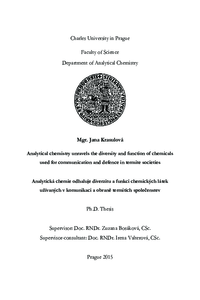Analytical chemistry unravels the diversity and function of chemicals used for communication and defence in termite societies
Analytická chemie odhaluje diverzitu a funkci chemických látek užívaných v komunikaci a obraně termitích společenstev
dizertační práce (OBHÁJENO)

Zobrazit/
Trvalý odkaz
http://hdl.handle.net/20.500.11956/81280Identifikátory
SIS: 82985
Kolekce
- Kvalifikační práce [20304]
Autor
Vedoucí práce
Konzultant práce
Valterová, Irena
Oponent práce
Pacáková, Věra
Lapčík, Oldřich
Fakulta / součást
Přírodovědecká fakulta
Obor
-
Katedra / ústav / klinika
Katedra analytické chemie
Datum obhajoby
4. 9. 2015
Nakladatel
Univerzita Karlova, Přírodovědecká fakultaJazyk
Angličtina
Známka
Prospěl/a
Klíčová slova (česky)
chemická ekologie, analytická chemie, plynová chromatografie, hmotnostní spektrometrie,identifikace, termiti, komunikační látky, obranné látkyKlíčová slova (anglicky)
chemical ecology, analytical chemistry, gas chromatography, mass spectrometry, identification, termites, communication compounds, defensive compoundsAnalytická chemie hraje klíčovou roli při studiu chemické ekologie a jen díky sofistikovaným metodám je možné detekovat biologicky aktivní látky, které se obvykle vyskytují v nepatrných množstvích, často jako složky komplexních směsí. Má práce je zaměřena na aplikaci moderních analytických metod a instrumentace při zjišťování identity, chemické diverzity a funkce semiochemikálií a obranných látek používaných různými druhy termitů. První část mé práce je zaměřena na identifikaci chemických látek používaných při komunikaci, tzn. feromonů. V této části jsem se zabývala studiem chemické komunikace při stopování u tří vybraných termitích druhů. Kromě nejběžnějšího termitího stopovacího feromonu, (3Z,6Z,8E)-dodeka-3,6,8-trien-1-olu, nalezeného u druhu Psammotermes hybostoma (Rhinotermitidae), jsem se podílela na identifikaci dvou nových struktur, (10Z,13Z)-nonadeka- 10,13-dien-2-onu u druhu Glossotermes oculatus (Serritermitidae) a syn-4,6-dimethylundekan-1-olu u druhu Hodotermopsis sjoestedti (Archotermopsidae). Podařilo se nám identifikovat také (3Z,6Z,8E)-dodeka-3,6,8-trien-1-ol jako samičí pohlavní feromon u druhu Psammotermes hybostoma, a syn-4,6-dimethylundekanal jako samčí pohlavní feromon u druhu Hodotermopsis sjoestedti. Identifikovala jsem také chemické složení vícesložkového poplašného...
Analytical chemistry plays a crucial role in studies on chemical ecology and only the development of sophisticated methods enables the detection of biologically active compounds that are usually present in minute quantities and often in very complex mixtures. My thesis is dedicated to the application of modern analytical techniques and instrumentation to unravel the identity, chemical diversity and function of semiochemicals and defensive compounds used by various species of termites. The first section of this thesis aims at the identity of chemicals used in communication, the pheromones. I studied the chemistry of the trail-following communication in three selected species of termites. Besides the identification of (3Z,6Z,8E)-dodeca-3,6,8-trien-1-ol, the most frequent termite trail-following pheromone, as the trail-following pheromone in Psammotermes hybostoma (Rhinotermitidae), I participated in the description of two new structures, (10Z,13Z)-nonadeca-10,13-dien-2-one in Glossotermes oculatus (Serritermitidae) and syn-4,6-dimethylundecan-1-ol in Hodotermopsis sjoestedti (Archotermopsidae). We identified (3Z,6Z,8E)-dodeca-3,6,8-trien-1-ol to be the female sex pheromone in Psammotermes hybostoma, and syn-4,6-dimethylundecanal to be the male sex pheromone in Hodotermopsis sjoestedti. I also...
